If you follow the world of finance, technology, or innovation, it’s nearly impossible to avoid conversations about cryptocurrencies. These digital assets have disrupted traditional notions of money, enabling decentralized and trustless transactions across the globe. Leading the pack of these crypto disruptors are Bitcoin and Ethereum—two heavyweights that dominate market capitalization rankings and drive much of the discussion around blockchain’s future. While Bitcoin emerged as the first and most famous cryptocurrency, Ethereum introduced a new paradigm by enabling programmable smart contracts. Each has a unique history, distinct technology, and passionate community backing it. So, the question naturally arises: Which crypto has more long-term potential?

Opinions abound.
Some will insist that Bitcoin, as the original cryptocurrency, retains the greatest longevity—akin to digital gold—and see it as the strongest store of value. Others argue that Ethereum’s flexible platform and robust developer ecosystem position it for exponential growth. We also see those who believe both can coexist, serving complementary but different roles in the ever-evolving crypto landscape.

The Conversation Regarding Crypto
The conversation about long-term potential is complex. It intersects with blockchain technology, macroeconomics, regulatory environments, and even philosophical perspectives on decentralization. For an investor or enthusiast, determining which asset has more staying power is crucial—particularly when dealing with an asset class as volatile and new as cryptocurrency. One might think Bitcoin’s simplicity gives it an edge: a fixed supply, a simple narrative (digital gold), and broad institutional acceptance. However, Ethereum’s capacity to power decentralized applications (dApps), execute smart contracts, and foster the rise of DeFi (Decentralized Finance) may suggest a broader set of use cases that propel it beyond a mere store of value.
To guide you through this debate, we’ll dive into six carefully structured sections.
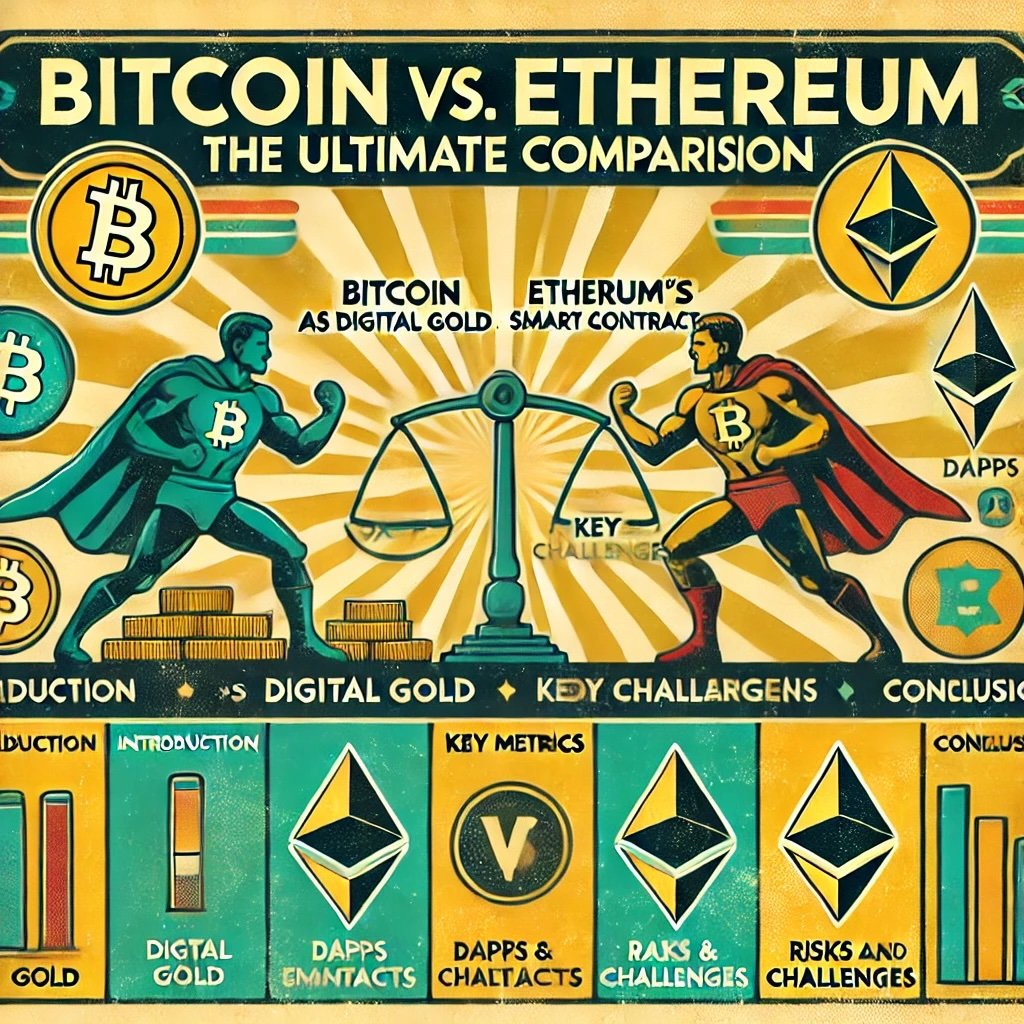
6 Sections:
- Introduction: Setting the stage for the Bitcoin vs. Ethereum clash.
- Bitcoin: The Pioneer and Digital Gold: Covering how Bitcoin arose and why it remains a powerhouse.
- Ethereum: The Smart Contract Revolution: Examining Ethereum’s more complex functionality and how it catalyzed DeFi and NFTs.
- Comparing Bitcoin and Ethereum: Key Metrics: Taking a side-by-side look at adoption, technology, and market position.
- Risks and Challenges for Both Cryptos: Highlighting hurdles, from regulatory scrutiny to technical bottlenecks.
- Conclusion: Summarizing it all and offering perspectives on diversification, co-existence, and the broader crypto narrative.
We’ll delve into each cryptocurrency’s origins, technology, adoption trends, and the risks each faces. This thorough overview won’t present a one-size-fits-all answer—because none exists. Instead, it should help you grasp the complexities, better appreciate the potential synergy (or rivalry) between these two giants, and make a more informed assessment of your own risk tolerance and investment strategy (while noting that nothing here is direct financial advice).
Ready to explore Bitcoin and Ethereum through a long-term lens? Let’s begin with the elder statesman, Bitcoin—often hailed as the digital gold of crypto.

Bitcoin: The Pioneer and Digital Gold
Bitcoin’s story is now the stuff of internet legend. Launched in January 2009 by the pseudonymous Satoshi Nakamoto, Bitcoin was conceived as a peer-to-peer electronic cash system that eliminates the need for centralized intermediaries such as banks. Its underlying innovation was the blockchain, a distributed ledger where all transactions are recorded and secured through cryptography. This invention solved the long-standing “double-spend” problem, allowing digital assets to be spent only once and verified by a global network of nodes.
Origins and Purpose
- Bitcoin’s White Paper: Published in October 2008 under the title Bitcoin: A Peer-to-Peer Electronic Cash System, it described a trustless, decentralized network where participants (miners) confirm transactions and earn newly minted bitcoins for doing so.
- Simplicity: Bitcoin’s code and structure focus primarily on transferring value from one address to another. Its primary function is facilitating transactions, storing value, and maintaining a secure ledger.
It’s straightforward yet revolutionary.
Over the years, Bitcoin has come to embody more than just a digital means of payment. Many view it as a store of value, comparing it to digital gold due to its limited supply of 21 million coins and its perceived resilience against inflationary pressures. This narrative has caught on with institutional investors, some of whom hold Bitcoin on their balance sheets.
Key Features
- Fixed Supply: Only 21 million bitcoins will ever exist, making it deflationary in nature.
- Proof-of-Work (PoW) Consensus: Miners solve cryptographic puzzles to validate transactions. This system, while energy-intensive, is considered highly secure.
- High Security: Bitcoin’s network is arguably the most battle-tested, with a decade-plus history of resisting attempted attacks.
- Simplicity of Purpose: It doesn’t aim to do everything—just decentralized value transfer.
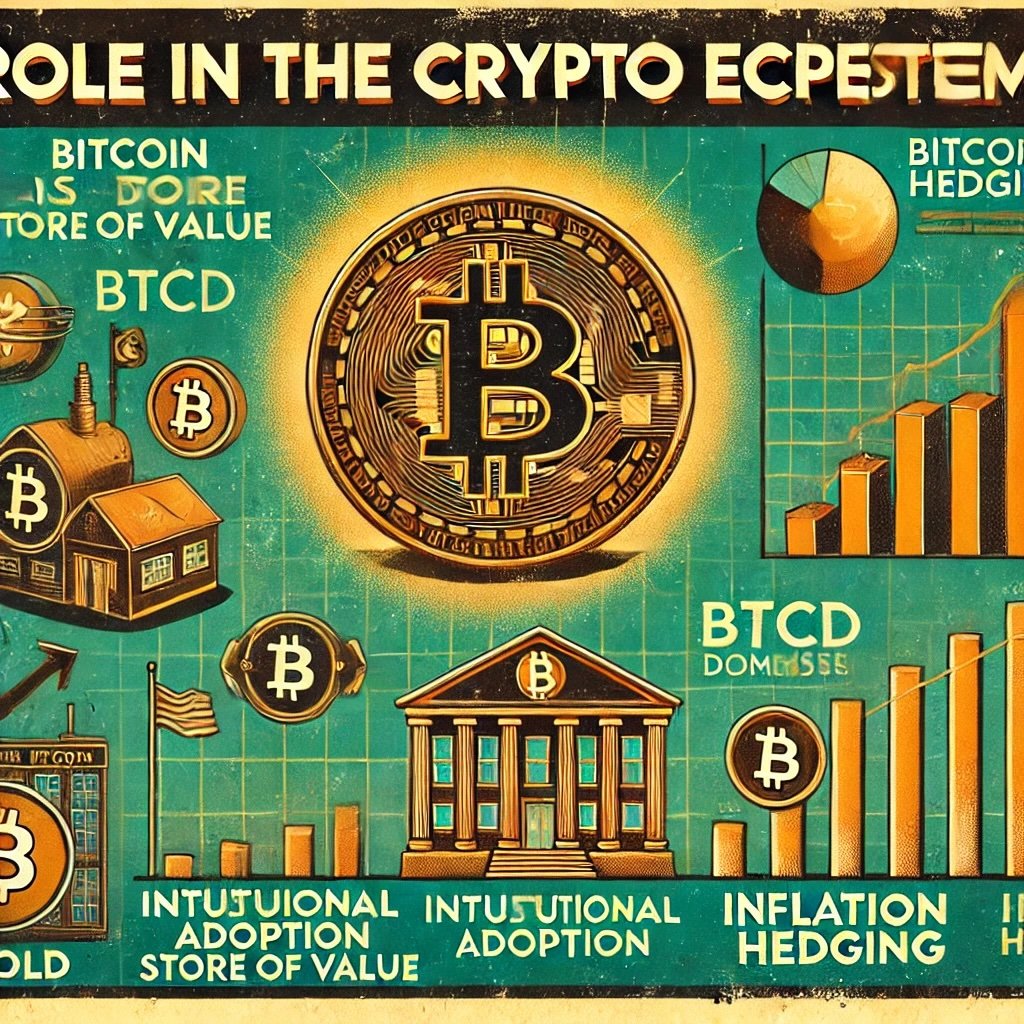
Role in the Crypto Ecosystem
Bitcoin’s dominance over the crypto market is often measured by Bitcoin Dominance (BTCD)—the ratio of Bitcoin’s market cap to the entire crypto market. Historically, BTCD has fluctuated but often exceeds 40–50%. This shows how pervasive Bitcoin’s role remains.
- Store of Value: Many investors buy Bitcoin not to spend it, but to hold, hoping it’ll appreciate or at least hedge against traditional market volatility.
- Inflation Hedge: Bitcoin’s limited supply appeals to those wary of central banks’ quantitative easing and fiat currency debasement.
- Institutional Adoption: We’ve seen an uptick in Bitcoin-focused exchange-traded funds (ETFs) in some jurisdictions, and major companies like MicroStrategy have bought billions of dollars worth of Bitcoin to hold on their balance sheets.
Challenges: Energy and Scalability
Despite its popularity, Bitcoin faces significant hurdles:
- Energy Consumption: The PoW mining process consumes large amounts of electricity, raising environmental concerns. Some advocates argue this usage will eventually shift to renewable resources, but critics remain vocal.
- Scalability: Bitcoin can only handle a handful of transactions per second on-chain. Solutions like the Lightning Network help with off-chain scaling, but critics question whether this approach is enough to handle massive global adoption.
- Regulatory Scrutiny: Governments worldwide debate Bitcoin’s legal status, from embracing it as legal tender (e.g., El Salvador) to banning it outright (e.g., some countries with strict currency controls).
It’s not a smooth road.
Bitcoin’s Long-Term Potential
As the oldest, most recognized crypto, Bitcoin boasts a first-mover advantage and unparalleled brand recognition. Many believe it will remain the gold standard for digital value storage, especially if more institutions adopt it as a hedge against inflation. Yet, Bitcoin’s utility for complex transactions is limited, and any dramatic updates to its core code happen slowly due to the network’s conservative governance approach.
- Digital Gold Narrative: If global uncertainty around fiat currencies grows, Bitcoin’s role as a store of value might strengthen, potentially pushing its price and market cap higher.
- Institutional Endorsement: As more major financial players (like pension funds, endowments, or publicly traded corporations) incorporate Bitcoin, its foothold as a mainstream asset class could solidify.
- Competition: Other cryptos don’t necessarily position themselves as direct replacements for Bitcoin’s store-of-value niche, focusing instead on other use cases (like Ethereum with smart contracts). This could further lock in Bitcoin’s dominance in the “digital gold” narrative.
In short, Bitcoin’s future is bright if it can maintain trust, secure its network with more sustainable energy solutions, and continue winning over institutional capital. However, some argue that Bitcoin’s technology is too rigid and that its overshadowing energy usage may spark regulatory pushback. Let’s now shift focus to Ethereum, which took the blockchain concept in a different, more programmable direction.

Ethereum: The Smart Contract Revolution
In 2013, a young programmer named Vitalik Buterin published a white paper proposing a next-generation blockchain that wouldn’t just track transactions but also execute arbitrary code—so-called “smart contracts.” Out of this vision, Ethereum was born. Officially launched in 2015, Ethereum soon became a powerhouse in the crypto world, introducing the concept of a programmable blockchain to a global audience of developers and entrepreneurs.
Origins and Vision
- Smart Contracts: Ethereum’s main innovation is allowing self-executing contracts written in code. This capability turned the blockchain into a universal platform, enabling decentralized applications (dApps) that operate autonomously, without a single point of control.
- Vitalik Buterin’s Influence: As a co-founder, Buterin provided Ethereum with a philosophically driven roadmap, emphasizing openness, community-driven governance, and continuous iteration.
Ethereum is more than just a token.
This approach contrasted starkly with Bitcoin’s limited scripting language, which was deliberately minimalistic to avoid complexity and potential security risks. Ethereum took a bolder route, sacrificing some simplicity for a flexible environment that could fuel an ecosystem of decentralized finance, non-fungible tokens (NFTs), gaming, social networks, and more.
Key Features
- Smart Contracts & dApps: Developers can program complex logic directly onto the Ethereum blockchain, enabling decentralized solutions across numerous industries.
- Transition to Proof-of-Stake (PoS): Initially launched with PoW, Ethereum is undergoing a multi-stage upgrade known as “Ethereum 2.0,” aiming to adopt PoS for improved scalability and energy efficiency.
- Flexible Programming Environment: Ethereum’s Turing-complete scripting language allows for intricate operations, from yield farming to NFT minting.
- Vast Developer Community: Thousands of projects build on Ethereum, fueling a vibrant ecosystem.
Role in the Crypto Ecosystem
Ethereum’s role isn’t just about transferring value—it’s about hosting entire digital economies. From DeFi protocols that replicate traditional financial services without intermediaries, to NFT marketplaces for digital art and collectibles, Ethereum’s adaptability is a magnet for innovation.
- Decentralized Finance (DeFi): Platforms like Uniswap, MakerDAO, and Aave exist predominantly on Ethereum, offering lending, trading, and stablecoins without centralized institutions.
- Non-Fungible Tokens (NFTs): Ethereum popularized NFTs, which represent unique digital assets like art, music, or in-game items.
- Enterprise Adoption: Major corporations have experimented with private or public Ethereum-based solutions, although permissioned versions may differ from the public network.
Transition from PoW to PoS
One of Ethereum’s most significant transformations is The Merge (completed in 2022), transitioning from energy-heavy PoW mining to a PoS model. PoS relies on validators who “stake” (lock up) their Ether (ETH) to validate transactions and secure the network, using far less energy than traditional mining. Additionally, Ethereum’s roadmap includes shard chains to improve throughput and reduce network congestion and fees.
Change is in the air.
While PoS is lauded for being more environmentally friendly, critics point out that it introduces different complexities and potential centralization risks if a few large stakeholders control a big chunk of ETH. Still, this upgrade is a cornerstone of Ethereum’s future.
Ethereum’s Long-Term Potential
If Ethereum successfully scales, reducing transaction costs and network congestion, it could cement its position as the go-to platform for decentralized apps. The versatility of its technology means it’s not limited to one type of use case. DeFi, gaming, identity solutions, supply chain tracking—almost any industry can theoretically leverage Ethereum’s smart contracts.
- Platform for Innovation: Many see Ethereum as analogous to an operating system for decentralized apps. If that analogy holds, its potential user base could be enormous, extending far beyond crypto enthusiasts.
- Developer Momentum: With the largest developer community in crypto, Ethereum enjoys a network effect—more developers create more apps, which attract more users, which attract more developers, and so on.
- Competition: Ethereum is not alone. Platforms like Solana, Cardano, and Polkadot offer alternatives with varying degrees of speed, scalability, and consensus mechanisms. Ethereum’s ability to stay ahead might hinge on its ability to innovate quickly while maintaining security.
The big question is whether Ethereum’s shift to PoS and ongoing upgrades will truly solve its scaling issues before competing blockchains lure away developers and users with cheaper fees. Nonetheless, Ethereum’s first-mover advantage in smart contracts and its massive ecosystem remain formidable assets.
Now that we’ve explored each cryptocurrency individually, it’s time to compare them head-to-head on key metrics, from market adoption to technological approaches.
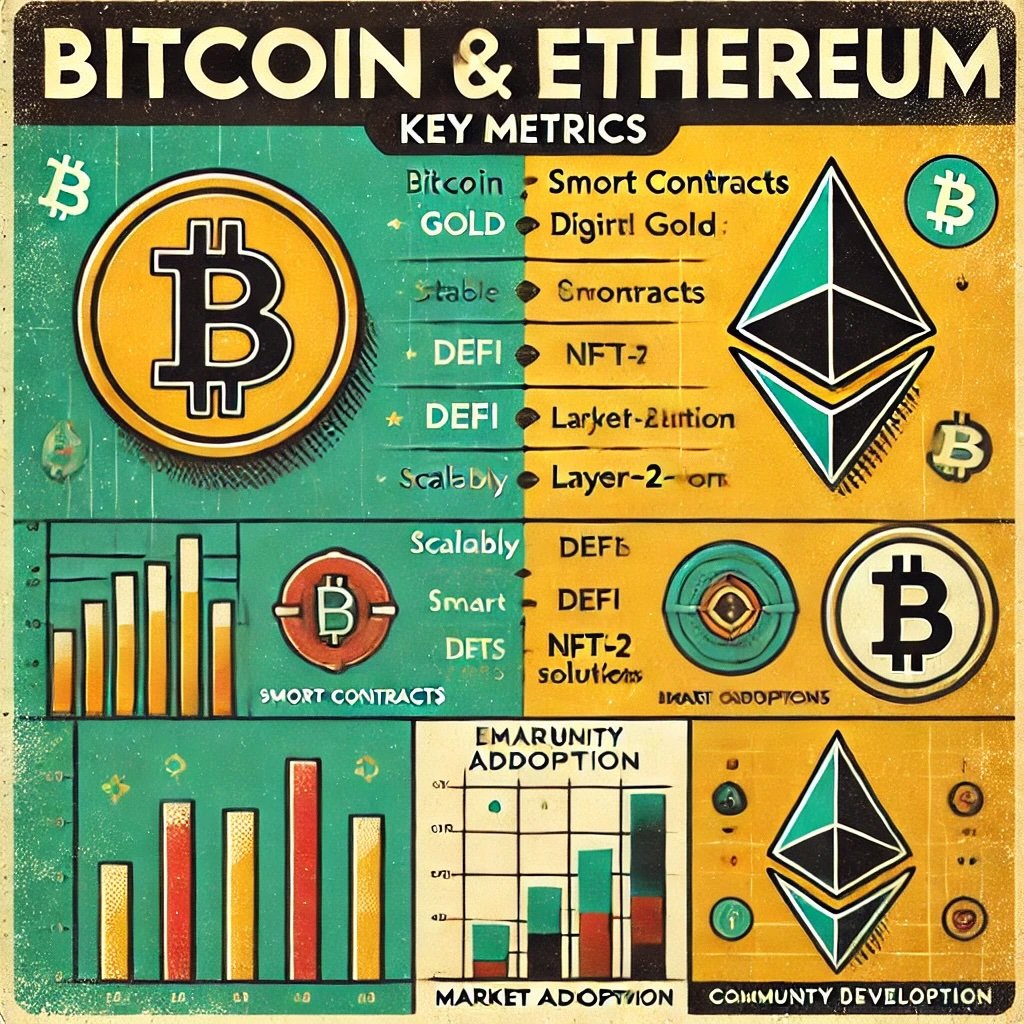
Comparing Bitcoin and Ethereum: Key Metrics
While both cryptos command massive market caps, Bitcoin and Ethereum occupy distinct niches. The following comparison illuminates how each project thrives and where they face hurdles.
Market Position and Adoption
- Bitcoin:
- Market Cap Leadership: Historically occupies the top slot by market capitalization.
- Global Recognition: Widely recognized even beyond crypto circles, often the gateway for new investors.
- Institutional Uptake: Used as a reserve asset by some companies and considered for ETFs.
- Ethereum:
- Second-Largest Market Cap: Often half or a fraction of Bitcoin’s, yet still substantial.
- Broader Ecosystem: Its total value locked (TVL) in DeFi might serve as a parallel measure of its ecosystem’s health.
- Investor Sentiment: Viewed not just as a currency but as a “tech investment” or “fuel” for dApps.
Bitcoin dominates for name recognition.
Use Cases
- Bitcoin:
- Primary: Store of value, digital gold, medium of exchange in some cases (e.g., remittances, El Salvador’s adoption).
- Secondary: Limited further utility due to minimal programmability, though side solutions like Lightning Network expand micropayment capabilities.
- Ethereum:
- Primary: Smart contracts, DeFi, NFTs, dApps, and more.
- Secondary: Acts as a currency in its ecosystem (gas fees), though not typically a store of value in the same sense as Bitcoin.
Ethereum’s utility extends far beyond simple transactions, making it essential for dApp developers and users. Bitcoin’s straightforward narrative can be beneficial, but it doesn’t capture the creative potential that Ethereum enables.
Scalability and Technology
- Bitcoin:
- Scaling Solutions:
- Lightning Network: Off-chain payment channels for faster, cheaper transactions.
- Block Size Debates: Historically contentious, leading to forks (e.g., Bitcoin Cash).
- Conservative Upgrades: The Bitcoin community is cautious about major protocol changes, focusing on security and decentralization.
- Scaling Solutions:
- Ethereum:
- Ethereum 2.0 (The Merge): A multi-phase upgrade to PoS, plus shard chains for parallel transaction processing.
- Scalability Tools: Layer-2 solutions like Optimistic Rollups (e.g., Optimism) or ZK-rollups (e.g., zkSync) reduce mainnet congestion.
- Faster Iteration: Ethereum’s developer community embraces experimentation and frequent protocol improvements.
Different pacing for change.
Environmental Impact
- Bitcoin’s PoW:
- Uses significant electricity. Critics highlight the carbon footprint, though defenders point to growing renewable use.
- Long-term sustainability concerns persist.
- Ethereum’s PoS:
- Slashes energy use drastically post-Merge (often cited as a ~99.9% reduction).
- Encourages “staking” instead of mining, which might be seen as more eco-friendly.
Community and Development
- Bitcoin:
- Development Approach: Deliberate and slow, with high emphasis on not breaking anything.
- Governance: Many independent stakeholders; major changes require broad consensus.
- Culture: Focus on decentralization, minimalism, and resilience.
- Ethereum:
- Development Approach: More aggressive roadmap, quicker adaptation to new ideas.
- Governance: Led partly by the Ethereum Foundation and Vitalik Buterin’s influence, but also shaped by a large open-source community.
- Culture: Innovative, developer-centric, sometimes prone to rapid changes that can be controversial.
Comparing these metrics underscores that Bitcoin and Ethereum serve distinct roles. Bitcoin often caters to those who want a secure, stable store of value. Ethereum appeals to builders, innovators, and those seeking a platform for complex decentralized applications. Many believe the two can coexist. Yet, each faces challenges that could impede future growth. Let’s address those risks next.
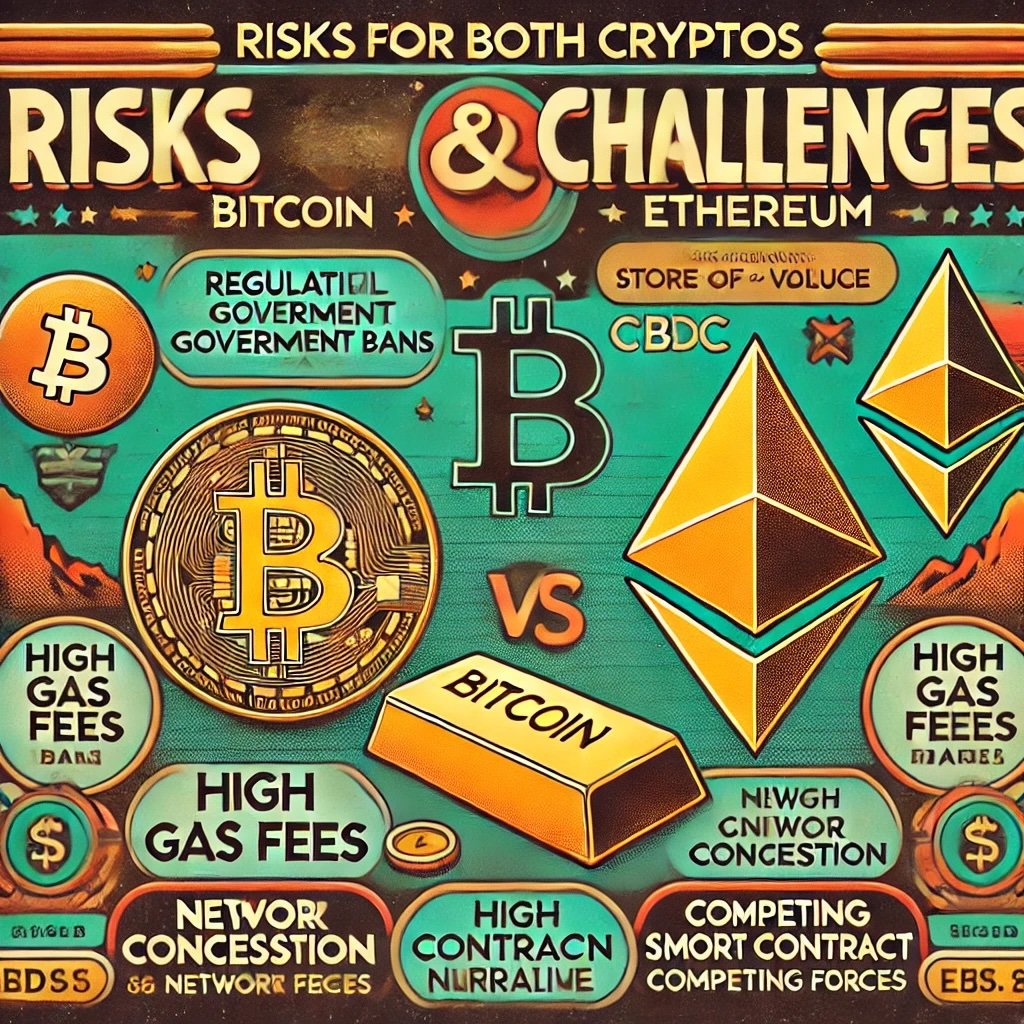
Risks and Challenges for Both Cryptos
Cryptocurrencies operate in a dynamic environment. From volatile price swings and uncertain regulations to internal technical hurdles, both Bitcoin and Ethereum must surmount substantial obstacles.
Bitcoin’s Challenges
- Regulatory Scrutiny and Potential Bans
- Some governments have either banned Bitcoin or severely limited its use, citing concerns about money laundering, capital flight, or consumer protection.
- Future legislation could hamper Bitcoin’s liquidity and widespread adoption.
- Competition from Central Bank Digital Currencies (CBDCs)
- As major economies explore CBDCs (like a digital dollar, digital euro, or digital yuan), Bitcoin’s role as a digital payment tool could face stiff competition from government-backed alternatives.
- While some see CBDCs coexisting with Bitcoin, others fear they might overshadow it.
- Over-Reliance on the Store of Value Narrative
- If global monetary conditions stabilize or if Bitcoin’s correlation with risk assets continues, the “digital gold” story might lose some luster.
- Alternative assets or newer cryptos could steal the spotlight.
Staying relevant is not guaranteed.
Ethereum’s Challenges
- Competition from Other Smart Contract Platforms
- Networks like Solana, Cardano, Polkadot, BNB Chain, and Avalanche promise faster throughput or cheaper fees.
- Ethereum’s high gas fees and network congestion have already pushed some users to competitor chains.
- Execution Risk with Ethereum 2.0
- Transitioning to PoS and implementing shard chains is complex. Delays or technical setbacks could hamper user confidence.
- If Ethereum’s upgrades take too long, developers might flock to other blockchains.
- Dependence on Community-Driven Upgrades
- Ethereum’s open-source nature means it relies heavily on community consensus for major changes.
- Divergent stakeholder interests can lead to contentious forks, exemplified by the Ethereum vs. Ethereum Classic split in 2016.
General Risks: Market Volatility, Security, and Evolving Regulations
Both Bitcoin and Ethereum inhabit a broader ecosystem rife with uncertainties:
- Market Volatility: Prices can surge or crash by double-digit percentages in a single day, causing emotional roller coasters for investors and forcing liquidation events.
- Security Breaches: While the blockchains themselves are robust, hacks often target bridges, exchanges, or DeFi protocols. If a major exploit occurs, trust can erode quickly.
- Legal Shifts: From tax policies to outright bans, governments keep adjusting their stance on crypto. Both Bitcoin and Ethereum must adapt to these ever-changing legal landscapes.
Given these risks, many crypto veterans advise diversification and caution. Bitcoin might remain a bedrock store of value, Ethereum a versatile platform, but neither is immune to global events, policy changes, or the inherent volatility of a nascent asset class.
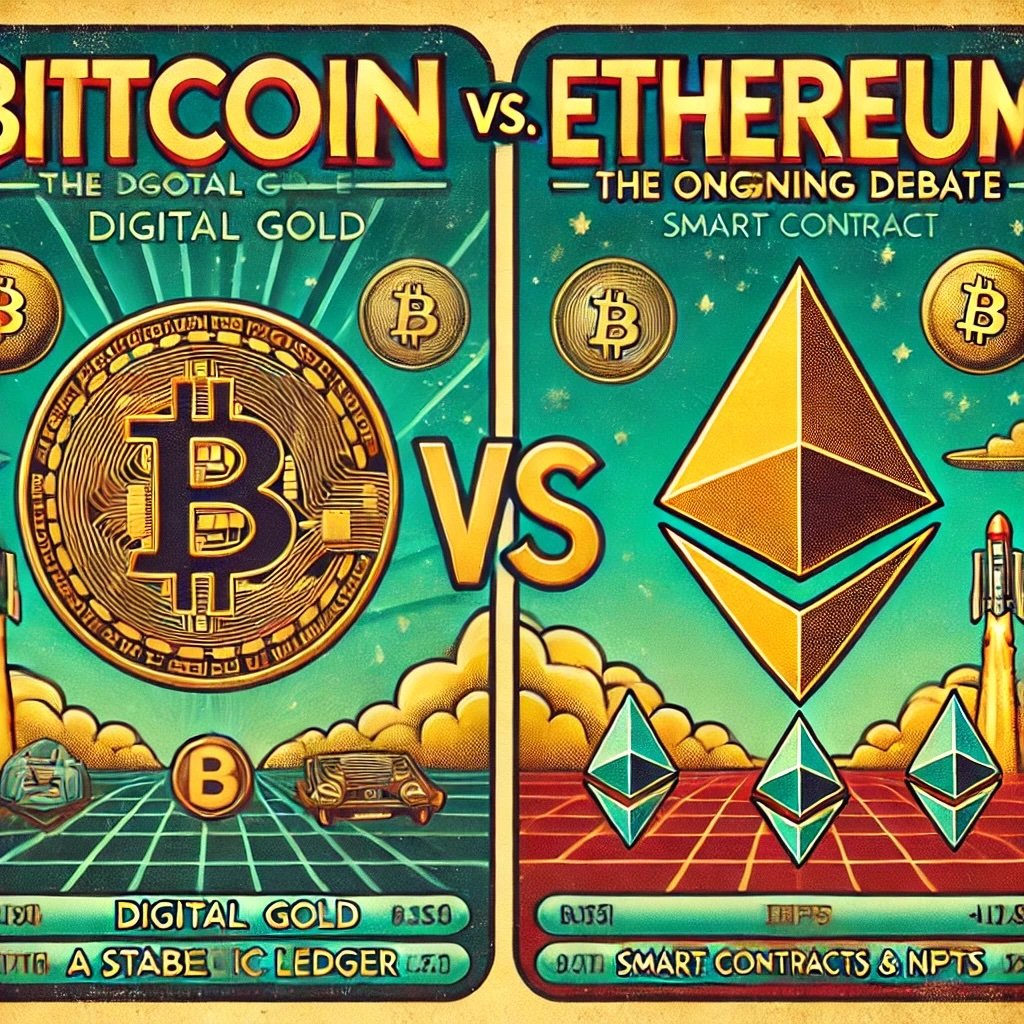
Bitcoin vs. Ethereum — 12-Question FAQ
1) What’s the simple, big-picture difference?
Bitcoin targets one job—scarce, censorship-resistant money (“digital gold”).
Ethereum is a programmable platform for smart contracts and apps (DeFi/NFTs/identity), with ETH as its native asset (and gas).
2) How do their monetary policies differ?
BTC supply is hard-capped at 21 million with predictable halvings.
ETH has no fixed cap; issuance is dynamic and offset by fee burns (EIP-1559). Net supply can shrink or grow depending on network activity and staking rewards.
3) What about consensus and energy use?
Bitcoin uses Proof-of-Work (PoW): extremely secure, energy-intensive.
Ethereum uses Proof-of-Stake (PoS): dramatically lower energy footprint, security tied to staked ETH.
4) Which scales better for everyday transactions?
Bitcoin: Lightning Network enables fast, low-fee payments off-chain.
Ethereum: Layer-2 rollups (Optimistic & ZK) scale smart-contract activity and payments, with mainnet as settlement.
5) Where is developer activity strongest?
Ethereum leads in smart-contract tooling, dApps, DeFi and NFT infrastructure. Bitcoin development is conservative, focused on core protocol, Lightning, and emerging layer-2s (e.g., covenants, sidechains).
6) What are the primary use cases today?
Bitcoin: long-term store of value, reserve asset, permissionless settlement, cross-border savings.
Ethereum: programmable finance (DEXs, lending, stablecoins), tokenization, NFTs, gaming, identity, and enterprise experiments.
7) How do security models compare?
Bitcoin: security budget = block rewards + fees; PoW’s economic cost defends the chain.
Ethereum: PoS slashes misbehaving validators; economic finality and stake concentration are key watchpoints.
8) What are the main risks for each?
Bitcoin: policy/regulatory pressure, energy debates, fee-market maturation as block rewards decline.
Ethereum: execution risk on scaling roadmap, competition from other smart-contract chains, validator centralization concerns.
9) How do institutions typically view each?
Bitcoin often fits the “digital commodity / macro hedge” bucket (akin to gold).
Ethereum is viewed more like “crypto infrastructure/tech” exposure—higher utility breadth, potentially higher execution risk.
10) Which might have more long-term upside?
Depends on thesis:
If you believe in scarcity + neutrality as the killer feature → Bitcoin.
If you believe blockchain utility platforms will capture value from apps and tokenized assets → Ethereum.
Many investors own both to cover monetary and platform theses.
11) How could each win over a decade?
Bitcoin: stronger institutional adoption, healthy fee market, broader Lightning usage.
Ethereum: cheap/abundant blockspace via rollups, thriving app ecosystem, real-world tokenization (RWA), robust validator decentralization.
12) How might a balanced allocation look? (Not advice)
A common approach is a core/satellite: BTC as the monetary core, ETH as the innovation/platform satellite—sized to your risk tolerance, time horizon, and conviction in PoW money vs PoS platform utility.
Conclusion
Bitcoin vs. Ethereum: It’s an ongoing conversation with no definitive “right” answer. Both cryptocurrencies hold unique positions in the blockchain universe. Bitcoin is the progenitor, the digital gold, the iconic symbol that started it all. Ethereum is the upstart innovator, offering a programmable layer that extends the concept of blockchain beyond mere value transfer into a realm of decentralized applications, finance, and digital assets.
Summarizing Key Points
- Bitcoin
- Stability and Simplicity: Designed as a secure, decentralized ledger with a fixed supply.
- Adoption and Brand Recognition: The go-to crypto for institutions, a hedge against inflation, a symbol of “hard money.”
- Challenges: High energy usage (PoW), slow transaction throughput, regulatory concerns, and reliance on the store-of-value narrative.
- Ethereum
- Programmable Blockchain: Enables smart contracts, powering a massive ecosystem of dApps, DeFi protocols, and NFTs.
- Scaling Initiatives: Transitioning to PoS, exploring shard chains, and layer-2 solutions to alleviate congestion.
- Challenges: Fierce competition from other smart contract platforms, execution risk for Ethereum 2.0, and sometimes high transaction fees.
They both face obstacles.
Potential Co-Existence and Diversification
Far from a zero-sum game, Bitcoin and Ethereum often coexist in portfolios as complementary assets. One might hold Bitcoin for its store-of-value attributes, while also holding Ether (ETH) to participate in Ethereum’s growing decentralized ecosystem. Indeed, many market observers see them playing distinct roles:
- Bitcoin for digital gold, macroeconomic hedge, and a perceived “safe haven” among cryptos.
- Ethereum for exposure to the expanding dApp ecosystem, DeFi, NFTs, and a general bet on blockchain’s utility in everyday transactions.
Technological Evolution, Market Adoption, and Global Trends
Both networks are shaped by ongoing improvements in technology, changes in market sentiment, and the broader tides of globalization and regulation. If Bitcoin manages to integrate better scaling solutions and quell environmental concerns, it may reinforce its gold-like status and see further institutional adoption. If Ethereum smoothly transitions to PoS while scaling effectively, it could blossom into the global infrastructure layer for decentralized applications, reshaping industries beyond finance.
Yet, the crypto world remains unpredictable. New projects arise, user demands shift, and macroeconomic events can spur dramatic price action. This makes long-term predictions challenging. However, the track record of both Bitcoin and Ethereum proves their resilience.
Final Thought
Ultimately, the choice between Bitcoin and Ethereum—or the decision to hold both—depends on your investment thesis, risk tolerance, and belief in their future trajectories. Some investors keep them in a balanced crypto portfolio, aiming to capture the growth potential of decentralized applications (through Ethereum) while holding onto the “digital gold” security of Bitcoin. Others focus on one coin, aligning with personal convictions around monetary policy, technology, or sustainability.
There’s no one-size-fits-all answer.
The key is to stay informed, monitor technological advancements, watch how regulations evolve, and understand the underlying ethos of each network. Bitcoin’s unwavering stability and brand recognition, or Ethereum’s versatility and ambitious roadmap—each has unique value. In a fast-moving crypto ecosystem, both might thrive. Or one could ultimately overshadow the other. Only time will tell. But for now, these two titans stand side by side, charting a path toward broader blockchain adoption and redefining how we think about money, governance, and digital ownership.
Important Information
Comprehensive Investment Disclaimer:
All content provided on this website (including but not limited to portfolio ideas, fund analyses, investment strategies, commentary on market conditions, and discussions regarding leverage) is strictly for educational, informational, and illustrative purposes only. The information does not constitute financial, investment, tax, accounting, or legal advice. Opinions, strategies, and ideas presented herein represent personal perspectives, are based on independent research and publicly available information, and do not necessarily reflect the views or official positions of any third-party organizations, institutions, or affiliates.
Investing in financial markets inherently carries substantial risks, including but not limited to market volatility, economic uncertainties, geopolitical developments, and liquidity risks. You must be fully aware that there is always the potential for partial or total loss of your principal investment. Additionally, the use of leverage or leveraged financial products significantly increases risk exposure by amplifying both potential gains and potential losses, and thus is not appropriate or advisable for all investors. Using leverage may result in losing more than your initial invested capital, incurring margin calls, experiencing substantial interest costs, or suffering severe financial distress.
Past performance indicators, including historical data, backtesting results, and hypothetical scenarios, should never be viewed as guarantees or reliable predictions of future performance. Any examples provided are purely hypothetical and intended only for illustration purposes. Performance benchmarks, such as market indexes mentioned on this site, are theoretical and are not directly investable. While diligent efforts are made to provide accurate and current information, “Picture Perfect Portfolios” does not warrant, represent, or guarantee the accuracy, completeness, or timeliness of any information provided. Errors, inaccuracies, or outdated information may exist.
Users of this website are strongly encouraged to independently verify all information, conduct comprehensive research and due diligence, and engage with qualified financial, investment, tax, or legal professionals before making any investment or financial decisions. The responsibility for making informed investment decisions rests entirely with the individual. “Picture Perfect Portfolios” explicitly disclaims all liability for any direct, indirect, incidental, special, consequential, or other losses or damages incurred, financial or otherwise, arising out of reliance upon, or use of, any content or information presented on this website.
By accessing, reading, and utilizing the content on this website, you expressly acknowledge, understand, accept, and agree to abide by these terms and conditions. Please consult the full and detailed disclaimer available elsewhere on this website for further clarification and additional important disclosures. Read the complete disclaimer here.




